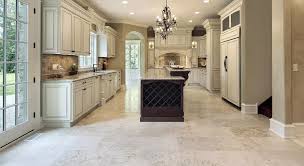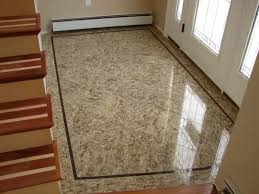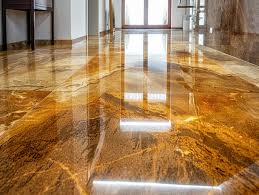Granite flooring stands as a hallmark of durability and elegance in the world of interior and exterior design. Renowned for its strength, versatility, and natural beauty, granite has been a favored material for centuries. Its ability to blend functionality with aesthetics makes it an ideal choice for both residential and commercial spaces.
What Is Granite Flooring?

Granite is an igneous rock formed through the slow cooling and solidification of magma beneath the Earth’s surface. This process results in a dense, hard, and durable material with unique patterns and colors. Granite flooring utilizes this natural stone to create surfaces that are not only visually striking but also exceptionally long-lasting.
Each granite slab is unique, characterized by its natural veining, specks, and patterns. This individuality ensures that no two granite floors are exactly alike, making it a sought-after material for those seeking one-of-a-kind designs.
Advantages of Granite Flooring
Granite flooring offers a host of benefits that make it a popular choice for various applications.
- Durability: Granite is one of the hardest natural stones, resistant to scratches, cracks, and chips. Its robustness ensures longevity even in high-traffic areas.
- Aesthetic Versatility: Available in a wide range of colors, patterns, and finishes, granite complements diverse design styles, from traditional to modern.
- Resistance to Moisture and Stains: When properly sealed, granite is resistant to moisture and stains, making it suitable for kitchens, bathrooms, and outdoor spaces.
- Heat Resistance: Granite withstands high temperatures without damage, ideal for use in areas exposed to heat, such as near fireplaces or underfloor heating systems.
- Low Maintenance: With regular cleaning and sealing, granite flooring maintains its appearance and functionality over time.
- Value Addition: Granite flooring adds a touch of luxury to any space, enhancing property value.
Challenges of Granite Flooring
While granite flooring has numerous advantages, it is important to consider some potential challenges.
- Cost: Granite can be more expensive than other flooring materials, reflecting its premium quality and durability.
- Weight: Its heavy nature requires a strong subfloor for support and professional installation.
- Porosity: Although less porous than marble, granite still requires sealing to prevent moisture penetration and staining.
- Cold Surface: Granite can feel cold underfoot, especially in cooler climates. This can be mitigated by using rugs or underfloor heating systems.
- Limited Availability of Uniform Patterns: Since granite is a natural stone, achieving consistent patterns across a large area can be challenging.
Types of Granite Finishes

Granite flooring is available in various finishes, each offering distinct aesthetic and functional qualities.
- Polished Finish: This finish enhances the natural colors and patterns of the stone, creating a glossy, reflective surface. It is popular for indoor spaces, adding a sense of luxury and sophistication.
- Honed Finish: A matte or satin finish, honed granite offers a more understated look. It is less slippery than polished granite, making it ideal for high-traffic areas.
- Flamed Finish: Achieved by exposing the stone to high heat, this finish creates a rough texture, perfect for outdoor spaces or areas requiring slip resistance.
- Brushed Finish: A soft, textured finish created using wire brushes, this option balances visual appeal with a non-slip surface.
- Tumbled Finish: This finish has a slightly worn, antique look, adding character to rustic or traditional interiors.
Granite Flooring in Different Spaces
Granite flooring is versatile enough to be used in a variety of settings, each benefiting from its unique properties.
- Living Rooms: Granite’s elegant appearance elevates the ambiance of living spaces, offering a timeless and sophisticated touch.
- Kitchens: Its resistance to heat and stains makes granite an excellent choice for kitchen floors and countertops.
- Bathrooms: Granite’s moisture resistance ensures it performs well in bathrooms, maintaining both functionality and style.
- Hallways and Entryways: Durable and visually impressive, granite creates a welcoming first impression in high-traffic areas.
- Outdoor Areas: The strength and weather resistance of granite make it ideal for patios, pathways, and poolside areas.
Installation of Granite Flooring
The installation of granite flooring requires precision and expertise to ensure a flawless finish. Professional installation is highly recommended due to the weight and complexity of the material.
The process typically involves:
- Preparing the Subfloor: The subfloor must be clean, level, and capable of supporting the weight of the granite. Any imperfections should be corrected before installation.
- Cutting and Laying the Tiles: Granite tiles are cut to size and laid out according to the desired pattern. Proper spacing and alignment are crucial for a seamless look.
- Applying Adhesive: A high-quality adhesive secures the tiles to the subfloor. Careful attention is given to ensure even application and proper bonding.
- Grouting: The gaps between tiles are filled with grout, providing stability and a finished appearance.
- Sealing: Sealing the granite protects it from moisture, stains, and scratches, enhancing its durability and ease of maintenance.
Maintenance of Granite Flooring

Granite flooring is relatively low maintenance, but regular care is essential to preserve its beauty and functionality.
- Cleaning: Sweep or vacuum regularly to remove dirt and debris. Use a damp mop with a granite-safe cleaner for deeper cleaning.
- Avoid Harsh Chemicals: Acidic or abrasive cleaners can damage granite. Opt for pH-neutral cleaning products specifically designed for natural stone.
- Sealing: Periodic sealing is necessary to protect granite from stains and moisture. The frequency depends on the type of granite and its exposure to wear and tear.
- Preventive Measures: Use rugs or mats in high-traffic areas to reduce wear. Place furniture pads under heavy items to prevent scratches.
Trends in Granite Flooring
Granite flooring continues to evolve with changing mancingduit design preferences, offering fresh and innovative ways to incorporate this timeless material.
- Neutral Tones: Shades of gray, beige, and white remain popular for their ability to create a clean and modern look.
- Bold Patterns: Unique and dramatic granite patterns are increasingly used as statement pieces in luxury interiors.
- Mixed Finishes: Combining different granite finishes in a single space adds depth and visual interest.
- Sustainable Choices: Reclaimed granite and eco-friendly sourcing practices are gaining traction among environmentally conscious consumers.
- Large Format Tiles: Oversized tiles create a seamless and contemporary aesthetic, ideal for open-plan spaces.
Choosing the Right Granite Flooring
Selecting the right granite flooring involves considering factors such as the intended use of the space, budget, and design preferences. Sampling various colors and finishes can help narrow down options, ensuring the chosen granite aligns with the overall aesthetic and functional requirements.
Consulting with professionals or experienced suppliers can provide valuable insights into the best granite type for specific needs. Additionally, investing in high-quality materials and installation ensures long-term satisfaction and durability.
Conclusion
Granite flooring remains a timeless and versatile choice for those seeking a blend of durability, elegance, and functionality. Its natural beauty, combined with its resilience, makes it suitable for a wide range of applications, from luxurious interiors to robust outdoor spaces. While it may require an initial investment and regular maintenance, granite flooring’s long-lasting appeal and performance make it a worthwhile addition to any property.
Read More Artice About: Es Pisang Coklat: Kombinasi Manis yang Menyegarkan di Setiap Gigitan
